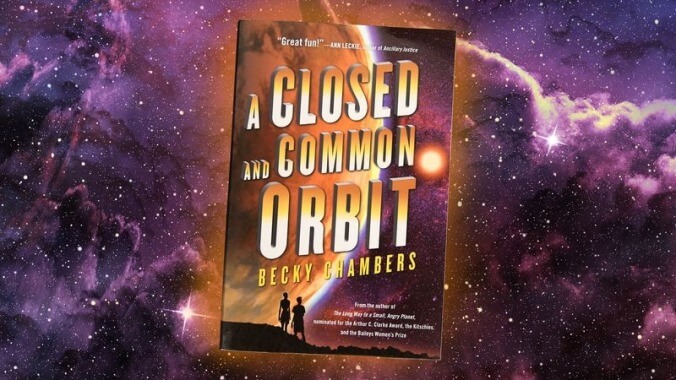Becky Chambers’ universe gets smaller in A Closed And Common Orbit

At first glance, Becky Chambers’ debut, The Long Way To A Small, Angry Planet, felt like sci-fi you’ve read or watched before—a crew of misfit aliens on a ship, setting aside their differences to work together on a mission. But in Chambers’ galaxy, the mission is the least important part of the story. The fate of worlds aren’t at stake; there’s no Death Star to be destroyed or MacGuffin to be recovered; there isn’t really even a villain. The book was far more concerned with the relationships between its characters, who were paired off in various combinations in each chapter.
Fortunately, it’s those relationships where Chambers excels. She has a gift for creating alien biology, culture, and social mores with far more depth and complexity than anything Star Trek’s forehead-of-the-week makeup department could churn out. Scaly, feathered Aandrisks, who treat physical contact the way we treat friendly chit-chat. Aeluons, who communicate with each other by changing color, and periodically switch genders. Sianats, a symbiotic host-parasite pair who together have a gift for navigating time and space. And, of course, humans, a minor species who have ruined their own planet and are scrabbling for a foothold in the wider galaxy.
The lack of urgency to Planet’s story didn’t matter. It was just a pleasure to spend time with the characters. Yet A Closed And Common Orbit makes a radical move for a sequel, abandoning the first book’s leads entirely in favor of two minor characters: Lovelace, the ship’s sentient on-board computer, now in a human-like body, and Pepper, the engineer who put her there. Lovelace gives herself the human-sounding name Sidra, and tries to adjust to having a physical form, while Pepper has to become a parent to a newly created person with a brilliant mind but a child’s limited understanding of the world. Complicating all of this is the fact that putting an AI in a body is very, very illegal, and the smallest slip-up could land them both in serious trouble.
The book’s chapters alternate between Sidra’s efforts to integrate into a planet’s culture without raising suspicions, and flashbacks to Pepper’s childhood as Jane 23, an anonymous child slave in a factory overseen by robots. Jane escapes and is protected by Owl, a downed spaceship’s AI, creating parallels in Pepper’s journey as both a child of, and a parent to, computers who strive to have an emotional relationship with her. Sidra misses the structure and safety of her intended purpose, while exploring the freedoms having a body gives her, while Pepper has to decide whether Sidra is a surrogate child or an experiment that could land her in jail if anything goes wrong.
While most sequels feel the need to go bigger and bolder, Orbit is a more intimate story than its predecessor, exploring trust, the mind/brain paradox, and unease with one’s body, while examining the ways someone without a family makes their way in the world and forms their own connections. As good as Chambers’ first book was at world-building, her second is more an attempt at world-cultivating, focusing in close on a small story that still suggests a wider galaxy worth exploring in further installments.
Purchasing A Closed And Common Orbit via Amazon helps support The A.V. Club.